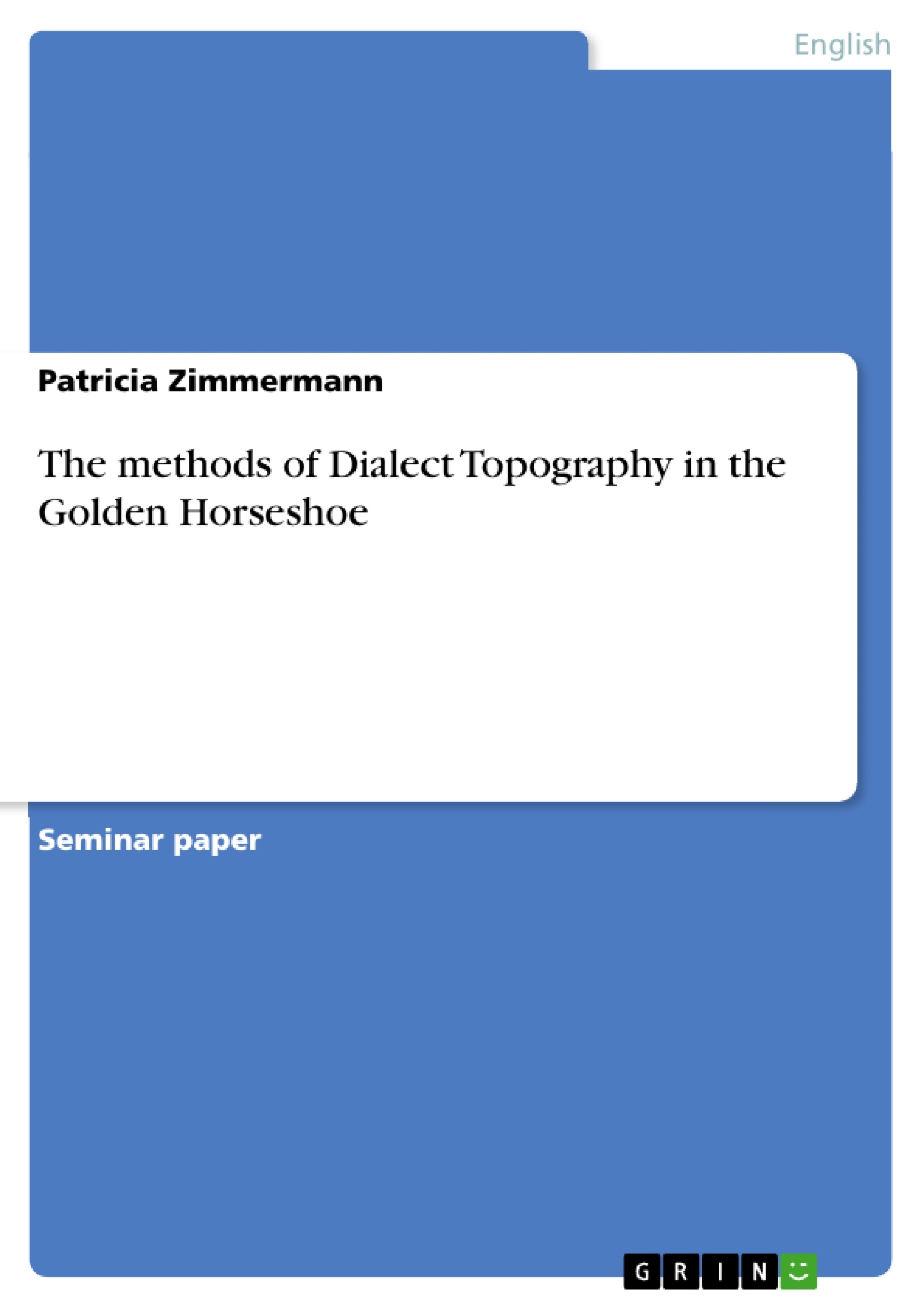Dialect topography was invented by J. K. Chambers. He used this method in the Golden
Horseshoe (v. 4.3 Survey area: The Golden Horseshoe ) for the first time. “Intended as an
alternative to dialect geography” (CHAMBERS 1994:35), dialect topography contains - like
dialect geography - methods for surveying dialect variants in a region. In its basics dialect
topography accords with dialect geography. “Both provide a macro-level perspective on
linguistic variation. Both survey people in a continuous area, making it possible to identify and
isolate gross linguistic differences among speakers from region to region. They can also provide
the basis for charting linguistic change in subsequent surveys” (CHAMBERS 1994:35-36).
Although both methods are very similar, there are two important differences which will be
discussed in the following passages.
In order to investigate the influence of non-native speakers on language use in the community,
J. K. Chambers invented the Regionality Index (RI). This mechanism allows to identify and
compare the languages of different test persons. The relationship between the subjects’ link to
the region can be investigated as well as to which extent the subject talks like a local. This
method will be discussed in the second part of this study.
Inhaltsverzeichnis (Table of Contents)
- Introduction
- Dialect geography
- The methods of dialectal geography
- The questionnaire
- The informant
- The methods of dialectal geography
- Dialect topography
- The informant
- Time-effectiveness
- Survey area: The Golden Horseshoe
- Cartogram of the Golden Horseshoe
- Critical view of the methods
- Questionnaire
- Distribution of age
- Distribution of sex
- Distribution of classes
- Regional distribution of respondents
- Regionality Index
- Critical view on the Regional Index
- Bibliography
Zielsetzung und Themenschwerpunkte (Objectives and Key Themes)
This study aims to explore the methods of dialect topography, invented by J. K. Chambers, and to understand its application in the Golden Horseshoe region. It examines the key differences and similarities between dialect topography and traditional dialect geography, particularly focusing on the methods employed and the selection of informants.
- Comparison of dialect topography and traditional dialect geography
- Influence of non-native speakers on language use
- Role of the informant in dialect studies
- Development and application of the Regionality Index (RI)
- The Golden Horseshoe as a case study for dialect research
Zusammenfassung der Kapitel (Chapter Summaries)
- Introduction: This chapter introduces dialect topography as a method developed by J. K. Chambers, specifically in the context of the Golden Horseshoe region. It highlights the similarities and differences between dialect topography and traditional dialect geography, emphasizing the methods used and the importance of informant selection.
- Dialect Geography: This chapter provides a brief overview of traditional dialect geography, outlining its historical development and key methods, including the use of questionnaires and the selection of informants. It discusses the evolution of informant selection criteria, from the "NORM" prototype to more inclusive approaches.
- The Methods of Dialectal Geography: This chapter focuses on the specific methods used in traditional dialect geography, such as the questionnaire and the informant. It explores the development of the questionnaire from its early use by Georg Wenker to the standardized approach used in contemporary research. It also discusses the evolution of informant selection criteria, highlighting the shift from focusing solely on "uneducated, untraveled, and old" individuals to more diverse approaches.
- Dialect Topography: This chapter delves into dialect topography, exploring its application in the Golden Horseshoe region. It examines the methods used, including the selection of informants, and discusses the time-effectiveness of this method. The chapter also includes a critical view of the methods employed, discussing aspects like the questionnaire, distribution of age, sex, and classes, as well as the regional distribution of respondents.
- Regionality Index: This chapter introduces the Regionality Index (RI), a tool developed by J. K. Chambers to investigate the influence of non-native speakers on language use. It outlines the purpose and application of the RI, examining how it can identify and compare the language of different test persons and their connection to the region.
Schlüsselwörter (Keywords)
This preview focuses on dialect topography, dialect geography, informant selection, the Golden Horseshoe region, and the Regionality Index (RI). It explores the methods used in dialectal research, the role of non-native speakers, and the evolution of informant selection criteria. The study examines how these methods and concepts contribute to a better understanding of linguistic variation and change.
- Arbeit zitieren
- Patricia Zimmermann (Autor:in), 2002, The methods of Dialect Topography in the Golden Horseshoe, München, GRIN Verlag, https://www.hausarbeiten.de/document/13759


